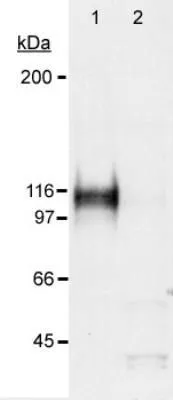HIF1 alpha Antibody (OASE00130)
OASE00130
ApplicationsImmunoFluorescence, Western Blot, ELISA, ImmunoCytoChemistry, ImmunoHistoChemistry
Product group Antibodies
TargetHif1a
Overview
- SupplierAviva Systems Biology
- Product NameHIF1 alpha Antibody (OASE00130)
- Delivery Days Customer23
- ApplicationsImmunoFluorescence, Western Blot, ELISA, ImmunoCytoChemistry, ImmunoHistoChemistry
- CertificationResearch Use Only
- ClonalityMonoclonal
- Clone IDESEE122
- Concentration1 mg/ml
- ConjugateUnconjugated
- Gene ID15251
- Target nameHif1a
- Target descriptionhypoxia inducible factor 1, alpha subunit
- Target synonymsHIF-1-alpha, HIF1-alpha, HIF1alpha, MOP1, bHLHe78, hypoxia-inducible factor 1-alpha, ARNT-interacting protein
- HostMouse
- IsotypeIgG1
- Scientific DescriptionHypoxia-inducible factor 1 (HIF1) is a heterodimeric transcription factor that plays a critical role in the cellular response of hypoxia (1). The HIF1 complex consists of two subunits, HIF1-Alpha and HIF1-Beta, which are basic helix-loop-helix proteins of the PAS family (2). HIF1 regulates the transcription of a broad range of genes that facilitate responses to the hypoxic environment, including genes regulating angiogenesis, erythropoiesis, cell cycle, metabolism and apoptosis. The widely expressed Hif-1alpha is typically degraded rapidly in normoxic cells by the ubiquitin/proteasomal pathway. Under normoxic conditions, Hif-1alpha is proline hydroxylated leading to a conformational change that promotes binding to the von Hippel Lindau protein (VLH) E3 ligase complex; ubiquitination and proteasomal degradation follows (3, 4). Both hypoxic conditions and chemical hydroxylase inhibitors (such as desferrioxamine and cobalt) inhibit Hif-1alpha degradation and lead to its stabilization. In addition, Hif-1alpha can be induced in an oxygen-independent manner by various cytokines through the PI3K-AKT-mTOR pathway (5-7).
- Storage Instruction-20°C
- UNSPSC12352203

